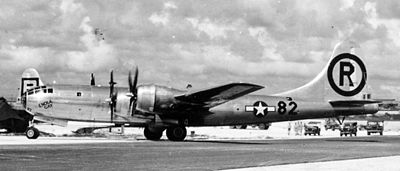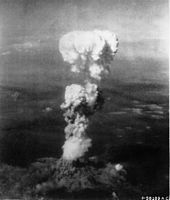From Wikipedia"
The Enola Gay is a Boeing B-29 Superfortress bomber, named for Enola Gay Tibbets, the mother of the pilot, Colonel Paul Tibbets, who selected the aircraft while it was still on the assembly line. On 6 August 1945, during the final stages of World War II, it became the first aircraft to drop an atomic bomb. The bomb, code-named "Little Boy", was targeted at the city of Hiroshima, Japan, and caused unprecedented destruction. Enola Gay participated in the second atomic attack as the weather reconnaissance aircraft for the primary target of Kokura. Clouds and drifting smoke resulted in Nagasaki being bombed instead.
After the war, the Enola Gay returned to the United States, where it was operated from Roswell Army Air Field, New Mexico. It was flown to Kwajalein for the Operation Crossroads nuclear tests in the Pacific, but was not chosen to make the test drop at Bikini Atoll. Later that year it was transferred to the Smithsonian Institution, and spent many years parked at air bases exposed to the weather and souvenir hunters, before being disassembled and transported to the Smithsonian's storage facility at Suitland, Maryland, in 1961.
In the 1980s, veterans groups engaged in a call for the Smithsonian to put the aircraft on display, leading to an acrimonious debate about exhibiting the aircraft without a proper historical context. The cockpit and nose section of the aircraft were exhibited at the National Air and Space Museum (NASM) in downtown Washington, D.C., for the bombing's 50th anniversary in 1995, amid a storm of controversy. Since 2003, the entire restored B-29 has been on display at NASM's Steven F. Udvar-Hazy Center. The last survivor of its crew, Theodore Van Kirk, died on July 28, 2014, at the age of 93.
The Enola Gay (Model number B-29-45-MO, Serial number 44-86292, Victor number 82) was built by the Glenn L. Martin Company (now Lockheed Martin) at its Bellevue, Nebraska plant, located at what is now known as Offutt Air Force Base. The bomber was one of 15 B-29s with the "Silverplate" modifications necessary to deliver atomic weapons. These modifications included an extensively modified bomb bay with pneumatic doors and British bomb attachment and release systems, reversible pitch propellers that gave more braking power on landing, improved engines with fuel injection and better cooling, and the removal of protective armor and gun turrets.
Enola Gay after Hiroshima mission, entering hard-stand. It is in its 6th Bombardment Group livery, with victor number 82 visible on fuselage just forward of the tail fin.
Thirteen days later, the aircraft left Wendover for Guam, where it received a bomb-bay modification, and flew to North Field, Tinian, on 6 July. It was initially given the Victor (squadron-assigned identification) number 12, but on 1 August, was given the circle R tail markings of the 6th Bombardment Group as a security measure and had its Victor number changed to 82 to avoid misidentification with actual 6th Bombardment Group aircraft.During July, the bomber made eight practice or training flights, and flew two missions, on 24 and 26 July, to drop pumpkin bombs on industrial targets at Kobe and Nagoya. Enola Gay was used on 31 July on a rehearsal flight for the actual mission.
The partially assembled Little Boy gun-type nuclear weapon L-11 was contained inside a 41-inch (100 cm) x 47-inch (120 cm) x 138-inch (350 cm) wooden crate weighing 10,000 pounds (4,500 kg) that was secured to the deck of the USS Indianapolis. Unlike the six Uranium-235 target discs, which were later flown to Tinian on three separate aircraft arriving 28 and 29 July, the assembled projectile with the nine Uranium-235 rings installed was shipped in a single lead-lined steel container weighing 300 pounds (140 kg) that was securely locked to brackets welded to the deck of Captain Charles B. McVay III's quarters. Both the L-11 and projectile were dropped off at Tinian on 26 July 1945.
On 5 August 1945, during preparation for the first atomic mission, Tibbets assumed command of the aircraft and named it after his mother, Enola Gay Tibbets, who had herself been named for the heroine of a novel. When it came to selecting a name for the plane, Tibbets later recalled that:
my thoughts turned at this point to my courageous red-haired mother, whose quiet confidence had been a source of strength to me since boyhood, and particularly during the soul-searching period when I decided to give up a medical career to become a military pilot. At a time when Dad had thought I had lost my marbles, she had taken my side and said, "I know you will be all right son."
On 5 August 1945, during preparation for the first atomic mission, Tibbets assumed command of the aircraft and named it after his mother, Enola Gay Tibbets, who had herself been named for the heroine of a novel. When it came to selecting a name for the plane, Tibbets later recalled that:
my thoughts turned at this point to my courageous red-haired mother, whose quiet confidence had been a source of strength to me since boyhood, and particularly during the soul-searching period when I decided to give up a medical career to become a military pilot. At a time when Dad had thought I had lost my marbles, she had taken my side and said, "I know you will be all right son."The name was painted on the aircraft on 5 August by Allan L. Karl, an enlisted man in the 509th. Regularly assigned aircraft commander Robert Lewis was unhappy to be displaced by Tibbets for this important mission, and became furious when he arrived at the aircraft on the morning of 6 August to see it painted with the now-famous nose art.
Hiroshima was the primary target of the first nuclear bombing mission on 6 August, with Kokura and Nagasaki as alternative targets. Enola Gay, piloted by Tibbets, took off from North Field, in the Mariana Islands, about six hours' flight time from Japan, accompanied by two other B-29s, The Great Artiste, carrying instrumentation, and a then-nameless aircraft later called Necessary Evil, commanded by Captain George Marquardt, to take photographs. The director of the Manhattan Project, Major General Leslie R. Groves, Jr., wanted the event recorded for posterity, so the takeoff was illuminated by floodlights. When he wanted to taxi, Tibbets leaned out the window to direct the bystanders out of the way. On request, he gave a friendly wave for the cameras.
Hiroshima explosion.
The release at 08:15 (Hiroshima time) went as planned, and the Little Boy took 43 seconds to fall from the aircraft flying at 31,060 feet (9,470 m) to the predetermined detonation height about 1,968 feet (600 m) above the city. Enola Gay traveled 11.5 mi (18.5 km) before it felt the shock waves from the blast. Although buffeted by the shock, neither Enola Gay nor The Great Artiste was damaged.
The detonation created a blast equivalent to 16 kilotons of TNT (67 TJ). The U-235 weapon was considered very inefficient, with only 1.7% of its fissile material fissioning. The radius of total destruction was about one mile (1.6 km), with resulting fires across 4.4 square miles (11 km2). Americans estimated that 4.7 square miles (12 km2) of the city were destroyed. Japanese officials determined that 69% of Hiroshima's buildings were destroyed and another 6–7% damaged. Some 70,000–80,000 people, or some 30% of the city's population, were killed by the blast and resultant firestorm, and another 70,000 injured. Out of those killed, 20,000 were soldiers.
Enola Gay returned safely to its base on Tinian to great fanfare, touching down at 2:58 pm, after 12 hours 13 minutes. The Great Artiste and Necessary Evil followed at short intervals. Several hundred people, including journalists and photographers, had gathered to watch the planes return. Tibbets was the first to disembark, and was presented with the Distinguished Service Cross on the spot.










2 comments:
What a classic plane....model looks great and I am sure it has a wing span to match.
The model has 3 foot wingspan.
Post a Comment